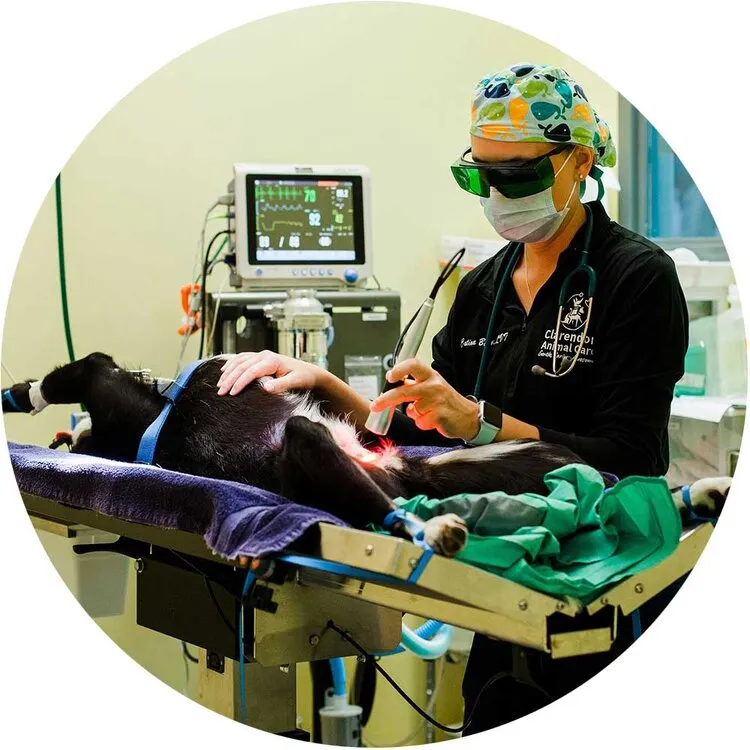
Class IV laser therapy treatment
We use the Summus Class IV Therapy Laser. It works on a specific wavelength of infrared and near-red light that improves oxygen delivery to the tissues, healing time, reduces pain, increases circulation, and decreases swelling.
We use the laser to help your cat or dog with their surgical incisions, wounds, lick granulomas, ear infections, arthritis, and many more conditions.
About laser therapy
You may have heard about laser lately or it has been recommended for your pet. Although, laser therapy is not a new concept, several veterinary hospitals have recently incorporated laser therapy into their treatment offerings due to the significant reported benefits on wound healing, pain management, and decrease in inflammation.
The first therapeutic laser was cleared by the U.S. Food and Drug Administration (FDA) in 2002. At Clarendon Animal Care, we are proud to offer treatments from the Summus Class IV Therapy Laser which was cleared by the FDA in March, 2005.

Patient receiving laser therapy post-op.
What is Laser Therapy?
Laser therapy, or “photobiomodulation,” is the use of specific wavelengths of light to create therapeutic effects while accelerating tissue regeneration. These effects include improved healing time, pain reduction, increased circulation and decreased swelling. Laser therapy can be used to aid in the management of almost any “-itis” – or inflammatory condition, especially arthritis and other orthopedic and neurologic conditions, surgical incisions, and skin conditions. It is important to remember that laser therapy utilizes therapeutic lasers and not surgical lasers. The latter is typically used to cut or ablate tissue and requires the patient to go under anesthesia.
How Does Laser Therapy Work?
Laser therapy treatment consists of utilizing specific wavelengths of light to cause photobiomodulation. Photobiomodulation occurs when light absorbed by the cells stimulates electrons and activates the cells to promote cellular repair. Laser energy increases circulation by drawing water, oxygen, and nutrients to the damaged cell area. This creates an optimal healing environment that reduces pain, inflammation, muscle spasm, and stiffness and leads to improved wound healing. Laser therapy can also be a great alternative to patients receiving chronic pain medication.
What to Expect?
During laser therapy treatment, patients typically do not require sedation and the experience is usually uneventful. Patients often experience improvement after the first laser therapy session, however, varying conditions may require several sessions (three to eight on average) for the treatment to be most effective. Treatment times will vary in length, but the duration of each session will be two to eight minutes for most conditions.
Is Laser Therapy Safe for Pets?
Laser therapy is exceptionally safe if performed correctly, using the proper settings and treatment durations. There is the potential for thermal burns if performed incorrectly, and we take special caution to protect our eyes as well as our patient’s eyes (though typically they are not able to look at the light beam, so they do not need to wear “doggles”).
Why Do We Recommend Laser Therapy?
Clarendon Animal Care has added laser therapy to our essential treatments because we want to provide a safe, painless, non-drug treatment option that will allow our patients to recover quickly while reducing pain effectively. During laser therapy treatment, our patients experience little or no pain sensation. At the most, patients will feel a mild warmth or tingling during treatment.
SUMMUS LASER VET CLIENT EDUCATION
The top ten biological effects of laser therapy (LT)
Clinical studies and trials of laser therapy technology indicate the following beneficial effects of laser therapy on tissues and cells:
- Anti-Inflammation. Laser Therapy has an anti-edema effect as it causes vasodilation, but also because it activates the lymphatic drainage system (drains swollen areas). As a result, there is a reduction in swelling caused by bruising or inflammation.
- Anti-Pain (Analgesic). Laser Therapy has a very beneficial effect on nerve cells by blocking pain transmitted by these cells to the brain and decreasing nerve sensitivity. Also, due to less inflammation, there is less edema and less pain. Another pain blocking mechanism involves the production of high levels of pain-killing chemicals such as endorphins, enkephalins, and opioids from the brain and adrenal gland.
- Accelerated Tissue Repair and Cell Growth. Photons of light from lasers penetrate deeply into tissue and accelerate cellular reproduction and growth. The laser light also increases the energy available to the cell by increasing ATP production so that the cell can take on nutrients faster and get rid of waste products. As a result of exposure to laser light, all cells, including the cells of tendons, ligaments and muscles are repaired faster.
- Improved Vascular Activity. Laser light will significantly increase the formation of new capillaries in damaged tissue; that speeds up the healing process, closes wounds quickly, and reduces scar tissue. In addition to angiogenesis, it causes temporary vasodilatation, an increase in the diameter of blood vessels.
- Increased Metabolic Activity. Laser Therapy creates higher outputs of specific enzymes, greater oxygen and food particle loads for blood cells.
- Trigger Points and Acupuncture Points. Laser Therapy stimulates muscle trigger points and acupuncture points on a non-invasive basis, providing musculoskeletal pain relief.
- Reduced Fibrous Tissue Formation. Laser Therapy reduces the formation of scar tissue following tissue damage from cuts, scratches, burns or surgery.
- Improved Nerve Function. Slow recovery of nerve functions in damaged tissue can result in numbness and impaired limbs. Laser light will speed up the process of axonal regeneration, nerve cell reconnection, and increase the amplitude of action potentials to optimize muscle action.
- Immunoregulation. Laser light has a direct effect on immunity status by stimulation of immunoglobulins and lymphocytes. Laser Therapy is absorbed by chromophores (molecule enzymes) that react to laser light. The enzyme flavomono-nucleotide is activated and starts the production of ATP (adenosine-tri-phosphate), which is the major carrier of cell energy and the energy source for all chemical reactions in the cells.
- Faster Wound Healing. Laser light stimulates fibroblast development (fibroblasts are the building blocks of collagen, which is predominant in wound healing) in damaged tissue. Collagen is the essential protein required to replace old tissue or to repair tissue injuries. As a result, Laser Therapy is effective on open wounds and burns.
“Just wow. We had an emergency with one of our kittens and called four places and the emergency vet and none could take us.
Clarendon Animal Care was so empathetic and agreed to take us at the end of the day. Every staff member-reception, techs, the vet—were so upbeat and friendly.”
— Emily Butler | Google Review
Veterinarian Careers – North Arlington
Hospital Support Careers – North Arlington

